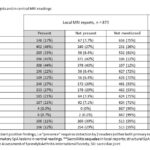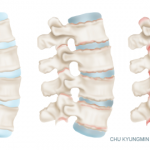Maksymowych et al. assessed the frequency of axial spondyloarthritis (axSpA) according to extra-articular presentation and human leukocyte antigen B27 (HLA-B27) status and sought to identify features that distinguish patients with axSpA from those with non-specific back pain. Their data support recommendations that patients with chronic back pain and extra-articular features related to axSpA be screened for axSpA with MRI and referred to a rheumatologist.

FDA Approves Bimekizumab-bkzx (Bimzelx) for 3 New Rheumatic Indications
The FDA has approved bimekizumab-bkzx for the treatment of adults with psoriatic arthritis, non-radiographic axial spondyloarthritis and ankylosing spondylitis.

An Approach to Physical Activity & Exercise in Axial Spondyloarthritis
‘Physical therapy is a mainstay of managing rheumatic diseases, but what’s the evidence, how do we monitor, and what types of therapy should we advocate?’ asks Physician Editor Bharat Kumar, MD, MME, FACP, FAAAAI, RhMSUS. ‘Here, we provide some practical recommendations for the everyday rheumatologist.’ Physical activity, including occupational and recreational activities, is one of…

Key Research in Axial Spondyloarthritis Encapsulated
Our understanding of (axSpA) has really changed, especially with regard to male-female differences. In this report, we identify important research on axSpA presented at ACR Convergence 2024, summarize the abstracts and comment on why each is important, addressing the relevance for clinicians and the potential impact on future research.

Are Sacroiliac Joint MRIs Accurate in Routine Clinical Practice?
Hadsbjerg et al. compared assessments of sacroiliac joint MRIs in local MRI reports from routine care in five European countries with re-reads by central experts in patients with a diagnosis of axial spondyloarthritis (axSpA) or psoriatic arthritis (PsA) to estimate the extent of over- or under-reporting of features and misclassification.

Approaches to Difficult-to-Manage Spondyloarthritis
At this ACR Convergence 2024 session, two experts spoke about identifying difficult-to-manage patients with spondyloarthritis, differentiating active disease from fibromyalgia & therapy selection in these patients.

Meet the Professor: Axial Spondyloarthritis
Axial spondyloarthritis (axSpA) is a complex, immune-mediated inflammatory disorder characterized by inflammatory back pain and axial arthritis. Typical of other diseases in the spondyloarthritis family, the clinical phenotypes can be diverse, and an array of comorbidities often accompanies the spinal disease. “In this Meet the Professor Session at ACR Convergence 2024,” says Christopher Ritchlin, MD,…

Difficult-to-Manage Spondyloarthritis
Studies show that patients with difficult-to-treat axial spondyloarthritis had more disease activity and greater peripheral involvement, with extra musculoskeletal manifestations and fibromyalgia. The ACR Convergence 2024 session on Difficult-to-Manage Spondyloarthritis will focus on patients for whom first- and second-line therapies have failed or who have persistent extra-axial manifestations of disease despite these treatment options. The…

Measures of Success
Can a treat-to-target strategy achieve better outcomes for patients with spondyloarthritis? Insights from the latest data.

Axial Spondyloarthritis: Research that Matters
Axial spondyloarthritis (axSpA), comprising ankylosing spondylitis (AS) and nonradiographic axial SpA, is the main form of chronic inflammatory arthritis affecting the axial skeleton. What research in axial spondyloarthrits to be presented at ACR Convergence 2024 has the greatest potential for a positive impact on clinical care, treatment options or serve as the basis for future…
- 1
- 2
- 3
- …
- 19
- Next Page »